Gardens featuring agapanthus are a true delight for any plant enthusiast. These striking flowers, often known as “African lilies,” bring a burst of color and elegance to outdoor spaces. With their unique clusters of blue or white blooms, they’re perfect for adding visual interest and attracting pollinators to your garden. Whether you’re a seasoned gardener or just starting out, incorporating agapanthus can enhance your outdoor experience effortlessly.
Agapanthus: A Splash of Blue in Your Garden
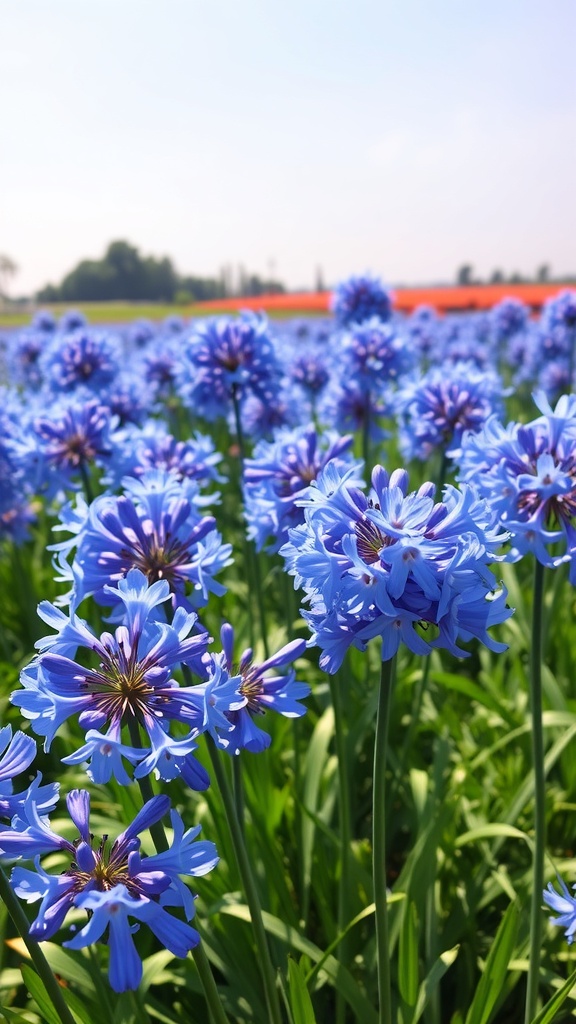
Agapanthus, often called the African lily, brings a delightful burst of blue to any garden. These flowers bloom in clusters, creating a stunning visual effect. Their vibrant hues can brighten up even the dullest spaces.
In the image, you can see a field filled with these beautiful blue flowers. The petals are soft and delicate, while the green stems provide a lovely contrast. This combination makes agapanthus a favorite among gardeners.
Planting agapanthus is simple. They thrive in well-drained soil and enjoy plenty of sunlight. With minimal care, they can flourish and add charm to your outdoor space. Imagine walking through a garden filled with these blooms, their colors dancing in the breeze.
Whether you have a small balcony or a large backyard, agapanthus can fit right in. They work well in borders, containers, or as standalone features. Adding these flowers can create a serene and inviting atmosphere.
Seasonal Changes: Agapanthus Throughout the Year
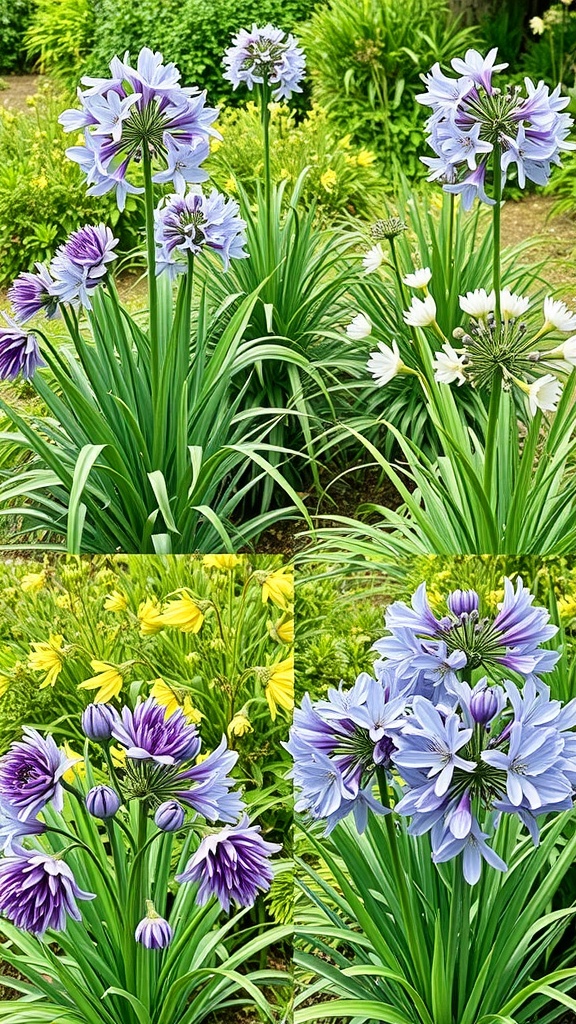
Agapanthus, with its striking blue and purple blooms, brings a splash of color to gardens throughout the year. In spring, these flowers begin to emerge, showcasing their vibrant petals against lush green foliage. The sight of agapanthus in full bloom is truly a delight, attracting butterflies and bees, making your garden feel alive.
As summer rolls in, the agapanthus plants reach their peak. The flowers stand tall, creating a stunning display. This is the time when gardeners can enjoy the full beauty of these plants. The rich colors and unique shapes of the flowers add a cheerful touch to any garden setting.
In the fall, the blooms start to fade, but the foliage remains lush and green. This is a great time to appreciate the structure of the plants. Even without flowers, agapanthus adds a nice texture to the garden landscape.
Winter brings a quiet period for agapanthus. The plants may die back, but their roots remain strong underground, ready to burst forth again in spring. This cycle of growth and dormancy is what makes agapanthus a resilient choice for any garden.
Designing Pathways with Agapanthus Borders
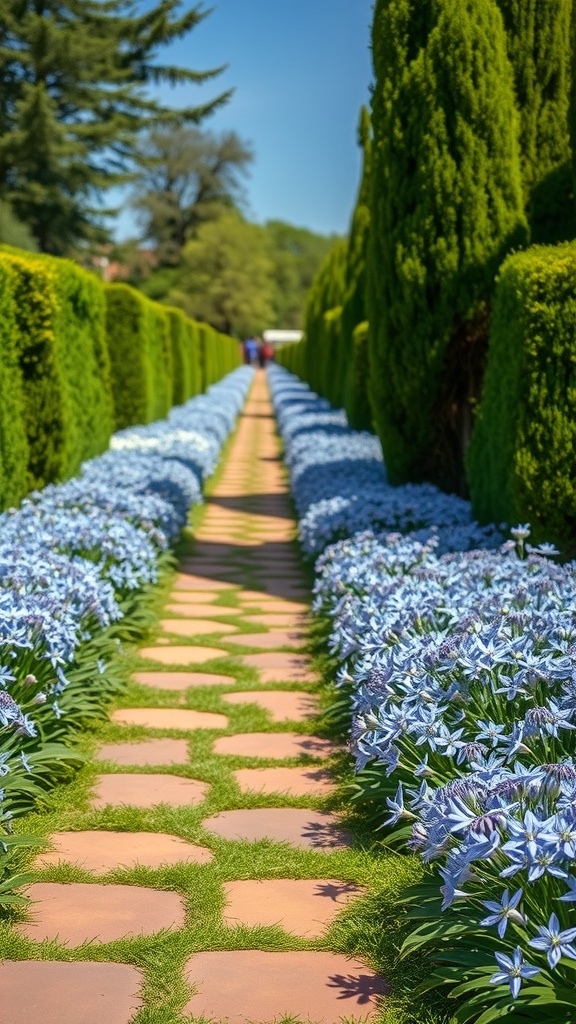
Creating pathways in your garden can be a delightful experience, especially when you frame them with beautiful agapanthus. These flowers, with their stunning blue hues, add a pop of color and charm to any walkway.
In the image, you can see a lovely path lined with agapanthus, creating a welcoming atmosphere. The soft, rounded stones lead the way, inviting visitors to stroll through the garden. The lush greenery on either side enhances the overall look, making the pathway feel like a serene escape.
When designing your own pathways, consider using similar stone patterns. They provide a natural feel and blend well with the surrounding plants. Agapanthus thrives in sunny spots, so placing them along the edges of your path ensures they get the light they need to flourish.
This design not only guides the eye but also encourages exploration. The vibrant flowers can attract butterflies and bees, adding life to your garden. So, whether you’re planning a new garden or updating an existing one, think about how agapanthus can enhance your pathways.
Agapanthus in Container Gardens
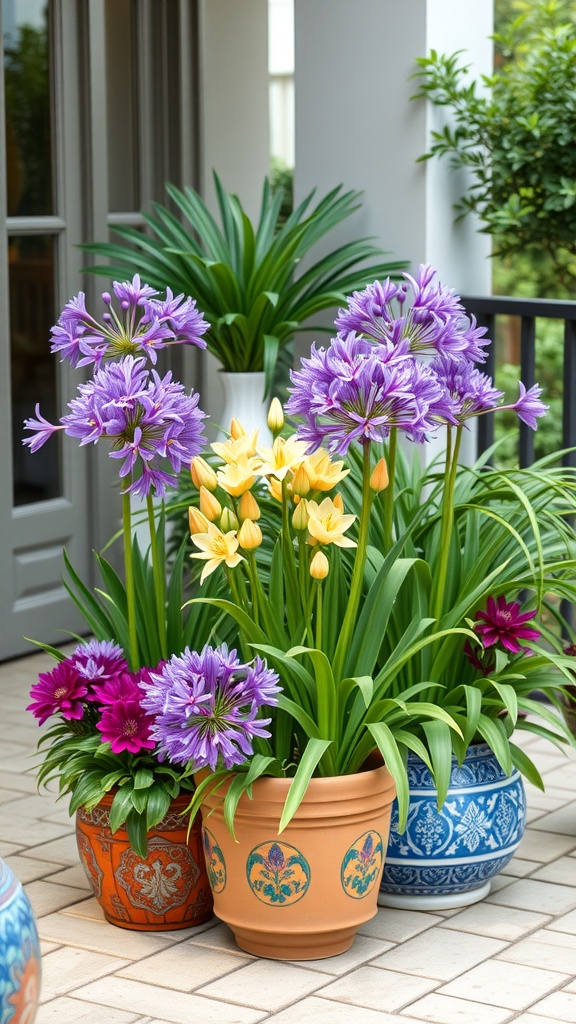
Agapanthus, with its stunning blue and purple blooms, is a fantastic choice for container gardens. The image showcases vibrant agapanthus plants in beautifully decorated pots, creating a lively atmosphere on a patio. These flowers add a splash of color and charm, making any outdoor space feel more inviting.
Container gardening allows for flexibility in design. You can mix agapanthus with other flowers, like the cheerful yellow blooms seen here, to create a stunning display. The combination of colors and shapes draws the eye and can brighten up even the smallest balcony or patio.
Choosing the right pots is key. The variety of designs, from terracotta to intricate patterns, adds character to your garden. These pots not only hold the plants but also contribute to the overall aesthetic. It’s easy to switch them out for different seasons or occasions, keeping your space fresh and exciting.
Agapanthus thrives in sunny spots, so placing them in containers allows you to move them around to catch the best light. With proper care, these plants can bloom beautifully, providing joy throughout the growing season. Container gardens with agapanthus are a delightful way to enjoy gardening, even in limited spaces.
Creating a Coastal Garden with Agapanthus
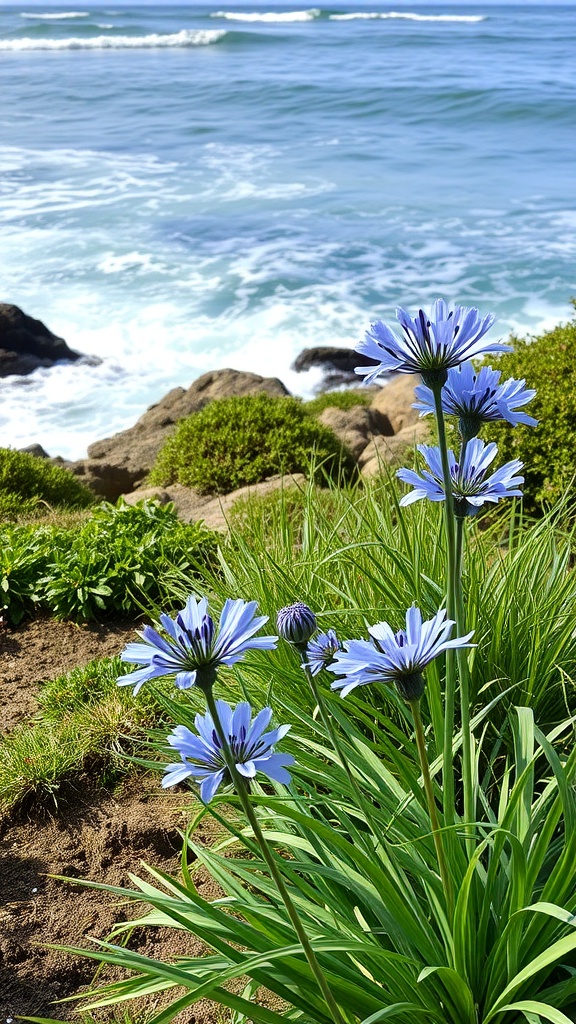
Agapanthus, with their stunning blue flowers, are perfect for coastal gardens. They thrive in sandy soil and can handle salty air, making them ideal for seaside locations. The image showcases these beautiful blooms against a backdrop of waves and rocky shores, highlighting their natural beauty.
When planting agapanthus, choose a spot that gets plenty of sunlight. They love the warmth and will reward you with vibrant flowers. Grouping them together can create a striking visual effect, especially when paired with other coastal plants.
Watering is essential, especially during dry spells. However, be careful not to overwater, as they prefer well-drained soil. Mulching around the base can help retain moisture while keeping weeds at bay.
Incorporating agapanthus into your garden not only adds color but also attracts pollinators. Bees and butterflies are drawn to their blooms, enhancing the overall ecosystem of your coastal garden.
Agapanthus Care: Tips for Thriving Blooms
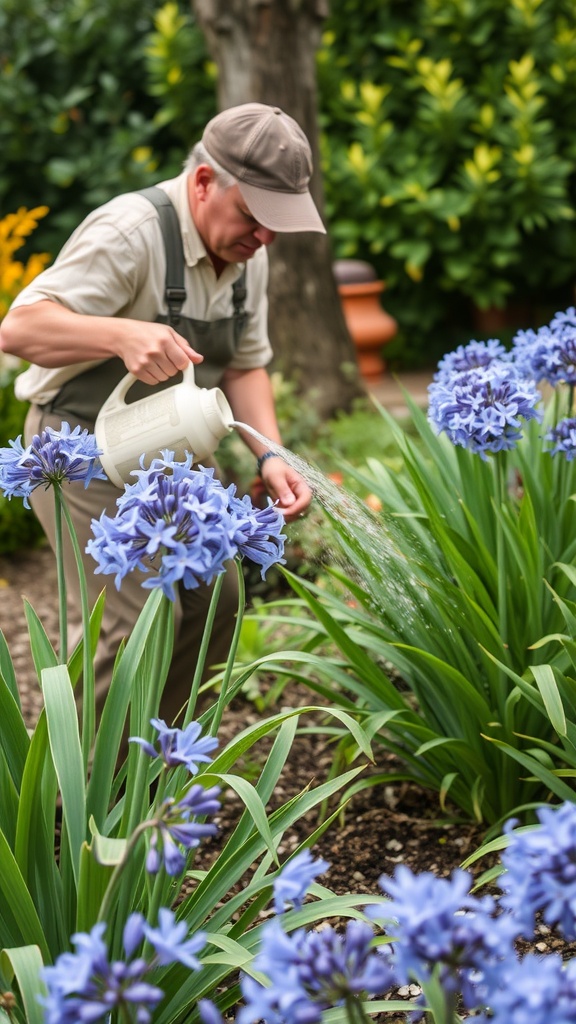
Agapanthus, with their stunning blue flowers, can truly brighten up any garden. In the image, we see a gardener carefully watering these beautiful blooms. This simple act is vital for keeping them healthy and vibrant.
To ensure your agapanthus thrive, start with the right soil. They prefer well-draining soil that retains some moisture. Regular watering is key, especially during dry spells. Just like in the photo, using a watering can helps you control the amount of water each plant receives.
Sunlight is another important factor. Agapanthus love the sun, so plant them in a spot that gets plenty of light. If you notice the leaves turning yellow, it might be a sign they need more sun.
Don’t forget about fertilizing! A balanced fertilizer in spring can give your plants the nutrients they need to produce those gorgeous flowers. With a little care, your agapanthus will reward you with a stunning display.
Companion Planting with Agapanthus
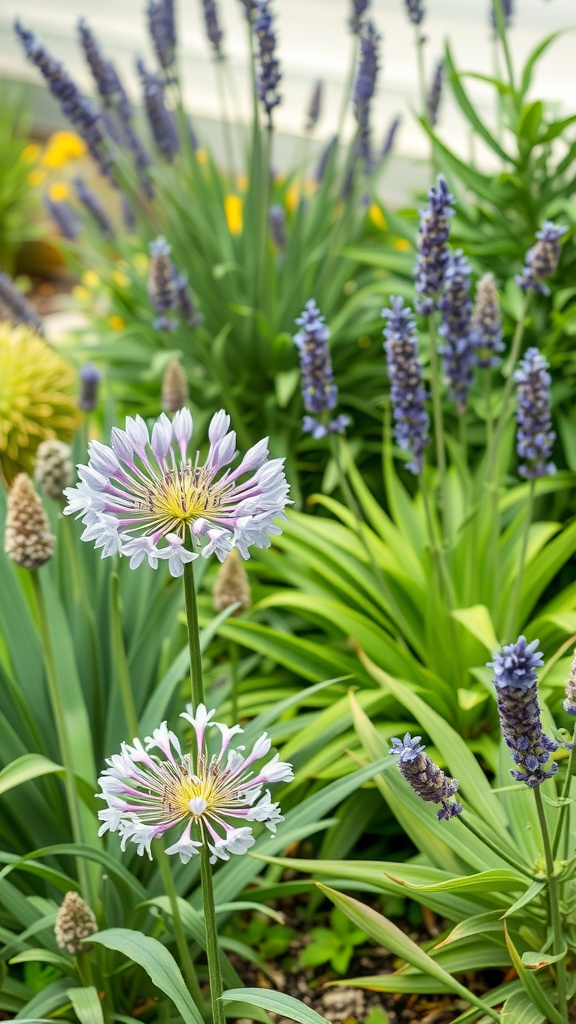
Agapanthus, with its striking blue and white flowers, makes a stunning addition to any garden. In this image, you can see agapanthus plants standing tall among other vibrant greenery. The mix of colors and textures creates a lively scene, showcasing how well these flowers can complement their surroundings.
When considering companion planting, agapanthus pairs beautifully with plants like lavender and ornamental grasses. The tall, spiky shapes of agapanthus contrast nicely with the softer forms of lavender. This combination not only looks great but also attracts beneficial pollinators to your garden.
Another great companion is the yellow flowering plant seen in the background. Its bright color adds warmth and enhances the visual appeal of the agapanthus. Together, they create a cheerful atmosphere, perfect for any outdoor space.
Using agapanthus in your garden can also help with pest control. Their strong scent can deter unwanted insects, making them a smart choice for a healthy garden. So, if you’re looking to create a vibrant and functional garden, consider adding agapanthus alongside other compatible plants!
Agapanthus Varieties: Choosing the Right Type for Your Space
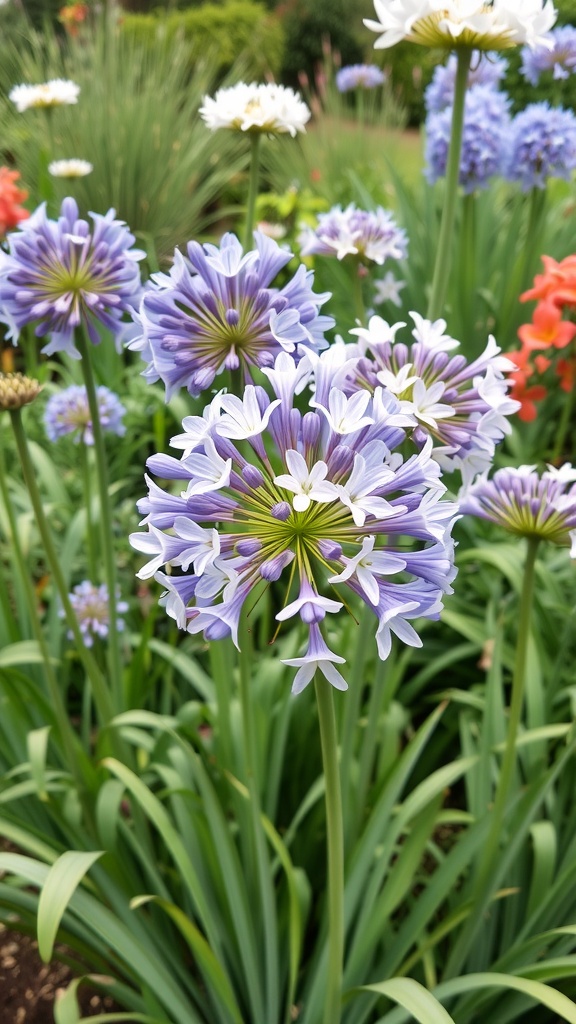
Agapanthus, often called lily of the Nile, brings a splash of color to gardens. The image shows a vibrant display of these flowers, showcasing their stunning blue and white blooms. With their tall stems and lush green leaves, they create a striking visual impact.
When selecting agapanthus varieties, think about your garden’s size and style. Some types grow taller, while others stay more compact. If you have a smaller space, consider the dwarf varieties that won’t overwhelm your garden.
Color is another fun factor. Agapanthus comes in shades of blue, purple, and white. Mixing different colors can create a lively atmosphere. Think about how these colors will blend with your existing plants.
Lastly, consider the climate in your area. Some agapanthus varieties thrive in warmer regions, while others are more tolerant of cooler temperatures. Choosing the right type ensures your garden flourishes.
Agapanthus and Wildlife: Attracting Pollinators
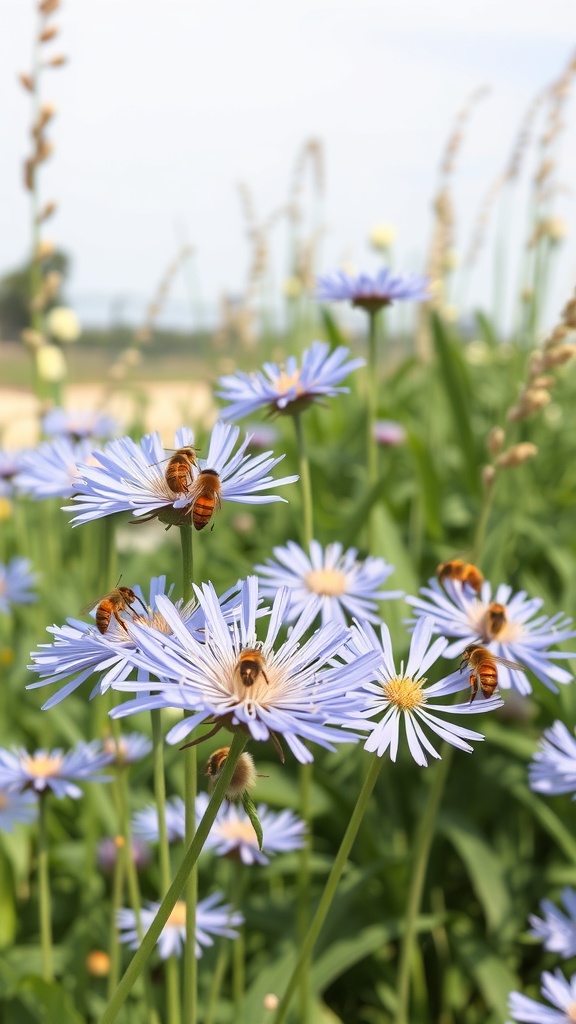
Agapanthus flowers are not just beautiful; they play a key role in attracting wildlife, especially pollinators like bees. The image shows these stunning blue flowers buzzing with activity as bees gather nectar. This interaction is vital for both the plants and the pollinators.
When you plant agapanthus in your garden, you create a welcoming space for these important creatures. The vibrant blooms provide food for bees, which helps in their survival. In return, the bees assist in pollinating the flowers, promoting healthy growth and more blooms.
Creating a garden filled with agapanthus can turn your outdoor space into a lively hub of activity. Watching bees flit from flower to flower is a delightful experience. It’s a simple way to contribute to the ecosystem while enjoying the beauty of nature.
Agapanthus in Mixed Flower Beds
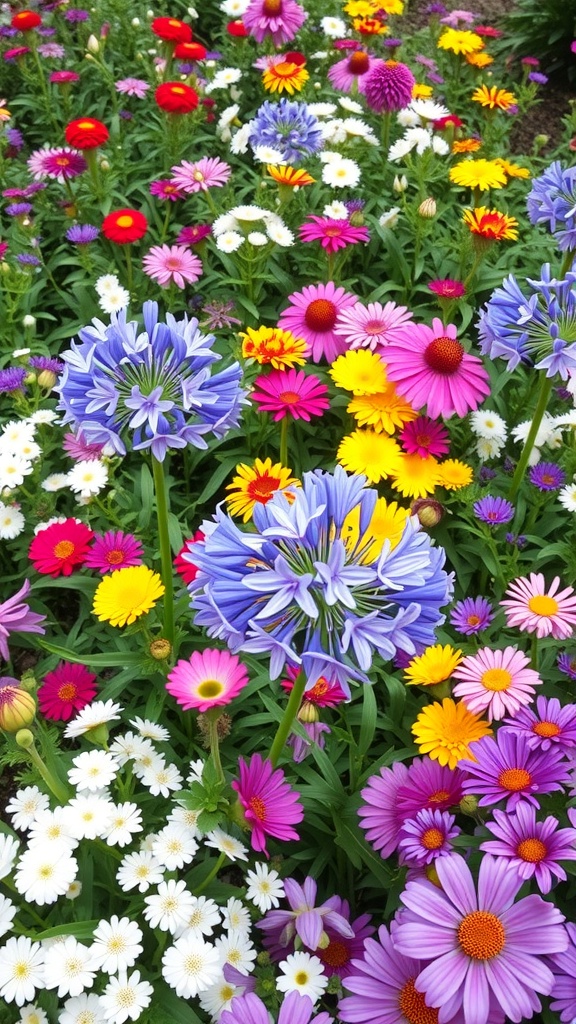
Agapanthus adds a unique charm to mixed flower beds. Its striking blue and purple blooms create a beautiful contrast against the vibrant colors of other flowers. In this image, you can see how agapanthus stands tall among daisies, gerbera daisies, and other cheerful blooms.
The combination of colors and shapes makes the garden lively and inviting. The round clusters of agapanthus flowers draw the eye, while the surrounding flowers provide a playful backdrop. This mix not only enhances the visual appeal but also attracts pollinators, making the garden a lively ecosystem.
When planting agapanthus with other flowers, consider their height and spacing. This ensures that each plant gets the sunlight it needs while allowing the beauty of each flower to shine. With the right mix, your garden can become a stunning display of nature’s artistry.
Using Agapanthus for Vertical Gardening
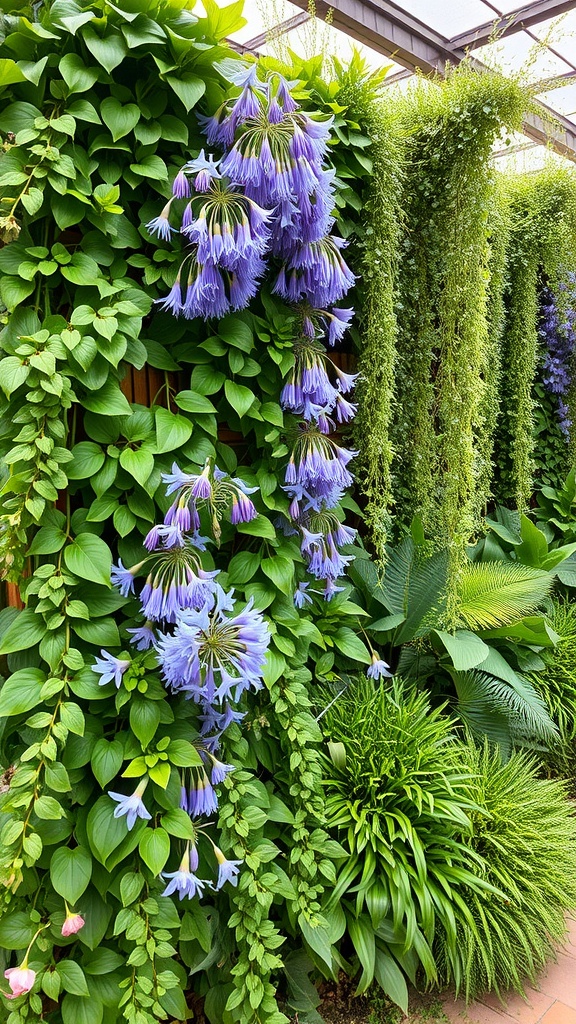
Agapanthus, with its stunning blue flowers, is a fantastic choice for vertical gardening. The image showcases how these beautiful plants can cascade down a wall, creating a vibrant display. The lush green leaves complement the flowers perfectly, adding depth and texture to the garden.
Vertical gardening is a great way to maximize space, especially in smaller areas. Agapanthus can thrive in pots or hanging planters, making them ideal for this style. Their striking blooms draw the eye, making any vertical setup a focal point.
When planting Agapanthus, consider their sunlight needs. They love bright, indirect light, which helps them flourish. Regular watering is essential, but be careful not to overwater. This balance keeps the plants healthy and encourages those beautiful blooms to flourish.
Incorporating Agapanthus into your vertical garden not only adds beauty but also creates a lush environment. Pair them with other climbing plants or trailing vines for a layered look. This combination can transform any wall into a stunning green space.
Agapanthus: A Low-Maintenance Garden Favorite
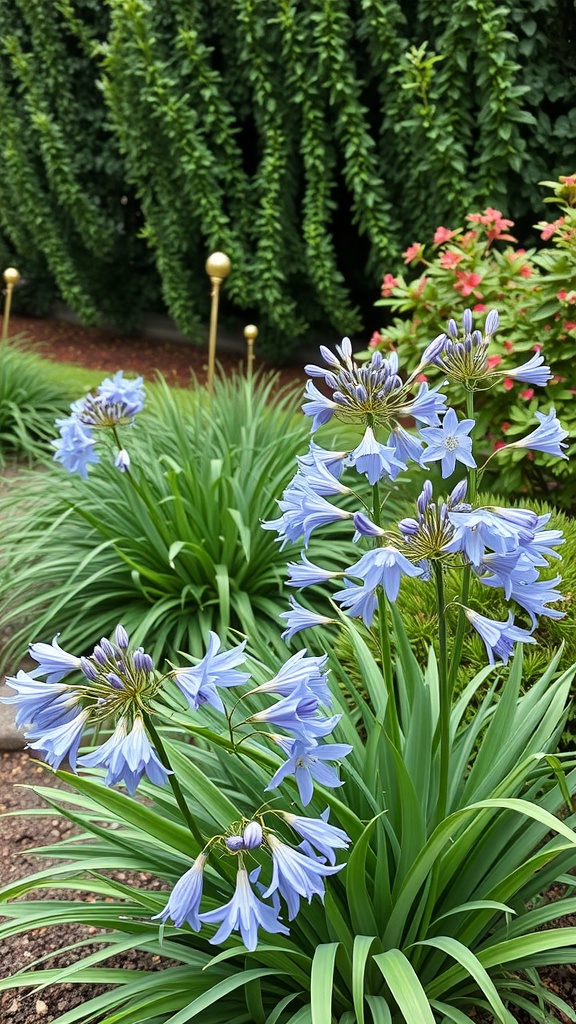
Agapanthus, often known as the African lily, brings a touch of charm to any garden. The image showcases clusters of stunning blue flowers, standing tall among lush green foliage. These blooms are not just pretty; they are also easy to care for, making them a favorite among gardeners.
In the picture, you can see how the agapanthus plants create a vibrant display. Their long, strap-like leaves provide a beautiful backdrop for the delicate flowers. This combination adds depth and texture to the garden, making it visually appealing.
Agapanthus thrives in various conditions, from sunny spots to partial shade. They are drought-tolerant once established, which means less worry about watering during hot months. This quality makes them perfect for busy gardeners or those new to gardening.
With their striking appearance and low-maintenance needs, agapanthus is a great choice for anyone looking to enhance their outdoor space. Whether planted in clusters or as standalone specimens, they are sure to impress.
Agapanthus as Cut Flowers: Bringing the Garden Indoors
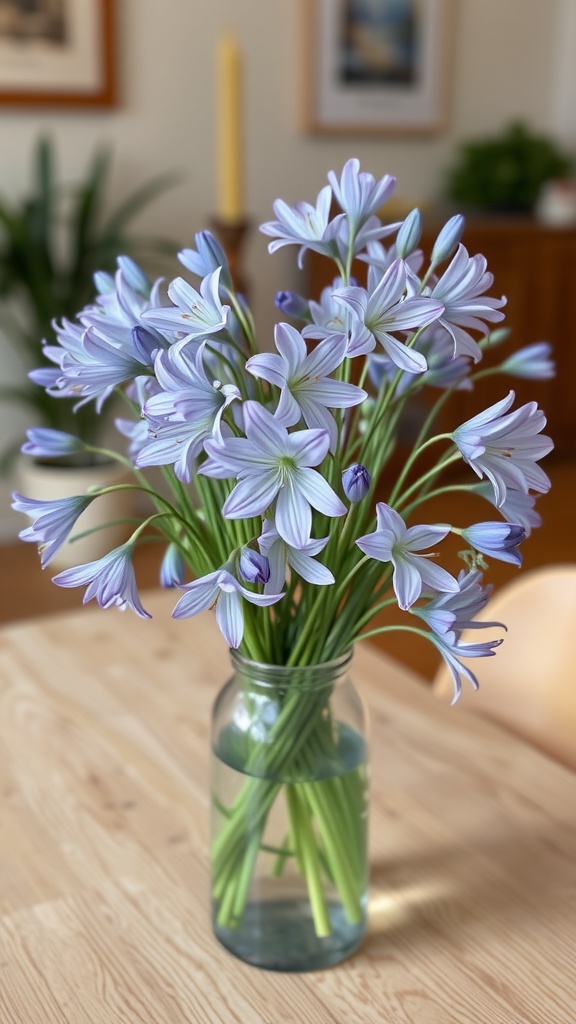
Agapanthus, with their stunning blue and purple blooms, make for delightful cut flowers. In the image, a beautiful bouquet of these flowers fills a simple glass vase, showcasing their elegance. The soft hues and unique shape of the petals add a touch of charm to any room.
Bringing agapanthus indoors can brighten up your space. They can last for days in a vase, especially when properly cared for. Make sure to trim the stems at an angle before placing them in water. This helps them absorb more water and stay fresh longer.
These flowers not only look great but also bring a bit of nature inside. Whether placed on a dining table or a side table, they create a welcoming atmosphere. Plus, they can be a conversation starter, sparking interest in gardening and floral arrangements.
The Cultural Significance of Agapanthus in Gardens
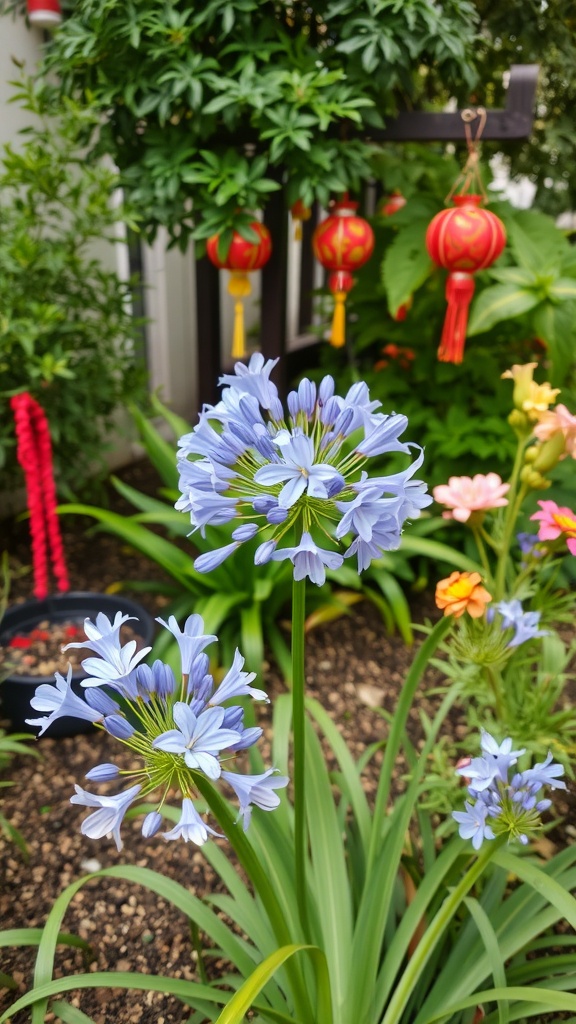
Agapanthus, often called the African lily, holds a special place in gardens around the world. Its stunning blue flowers create a beautiful sight, making it a favorite among gardeners. The image shows vibrant agapanthus blooms standing tall amidst a colorful garden backdrop, showcasing their charm.
In many cultures, agapanthus symbolizes love and unity. This makes it a popular choice for weddings and celebrations. The flowers’ striking appearance adds a touch of elegance to any event, making them more memorable.
Moreover, agapanthus is easy to grow and maintain, which appeals to both novice and experienced gardeners. Its resilience in various climates allows it to thrive in different settings, from urban gardens to rural landscapes. This adaptability contributes to its widespread popularity.
In addition to their beauty, agapanthus plants attract pollinators like bees and butterflies. This not only enhances the garden’s ecosystem but also supports local wildlife. By planting agapanthus, gardeners contribute to a healthier environment.
Landscaping Ideas Featuring Agapanthus
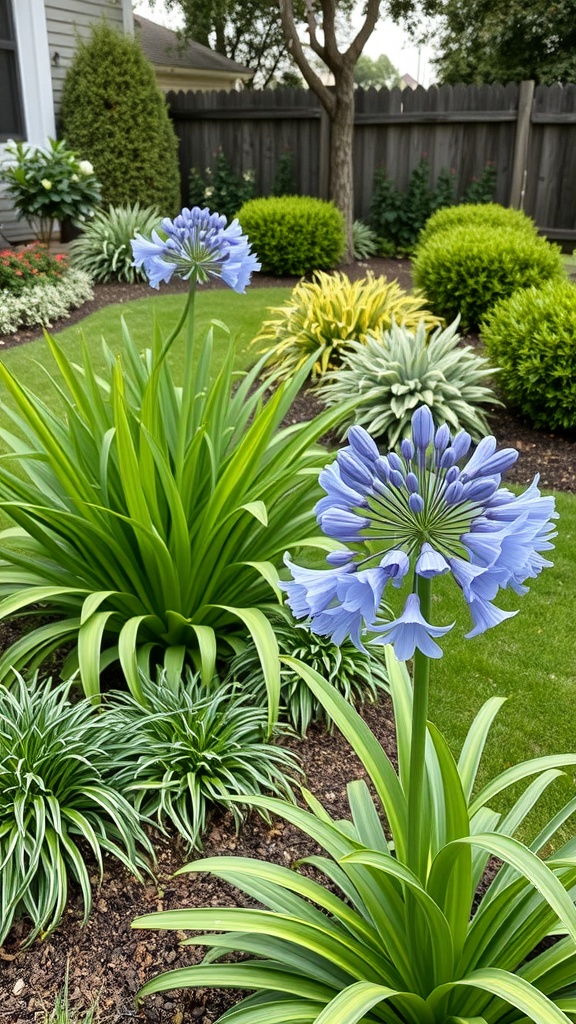
Agapanthus, with its striking blue flowers, adds a pop of color to any garden. These plants are perfect for creating focal points in your landscape. Their tall, elegant blooms rise above lush green foliage, making them stand out beautifully.
In the image, you can see agapanthus surrounded by a variety of other plants. The combination of textures and colors creates a vibrant scene. Pairing agapanthus with low-growing plants, like the striped varieties nearby, adds depth and interest.
Consider planting agapanthus in clusters for a more dramatic effect. They thrive in sunny spots and can be used along pathways or borders. Their unique shape and color will surely catch the eye of anyone passing by.
Don’t forget to think about the seasons. Agapanthus blooms in summer, so planting them alongside evergreens can ensure your garden looks great year-round. This way, you can enjoy the beauty of your landscape no matter the time of year.
